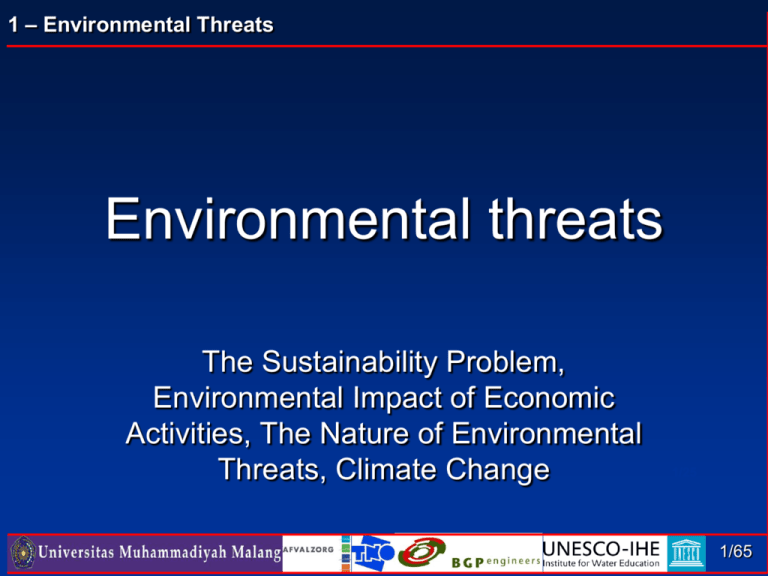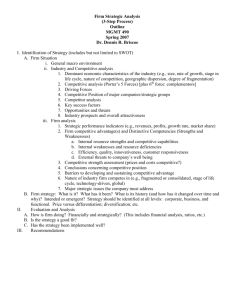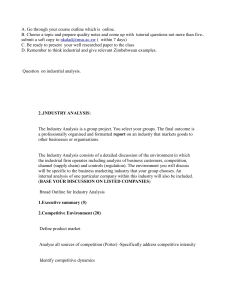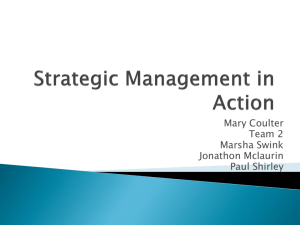1 – Environmental Threats
advertisement

1 – Environmental Threats Environmental threats The Sustainability Problem, Environmental Impact of Economic Activities, The Nature of Environmental Threats, Climate Change 1/25 1/65 1 – Environmental Threats 1.1 Environment and Climate Environment and Climate The Sustainability Problem, Environmental Impact of Economic Activities, The Nature of Environmental Threats, Climate Change 2/25 2/65 1 – Environmental Threats 1.1 Environment and Climate Contents • • • • The Sustainability Problem The Nature of Environmental Threats Current Global Environmental Threats The Challenge of Climate Change 3/25 3/65 1 – Environmental Threats 1.1 Environment and Climate The Sustainability Problem (1) Development involves a progressive transformation of economy and society. A development path that is sustainable in a physical sense could theoretically be pursued even in a rigid social and political setting. But physical sustainability cannot be secured unless development policies pay attention to such considerations as changes in access to resources and in the distribution of costs and benefits. Even the narrow notion of physical sustainability implies a concern for social equity between generations, a concern that must logically be extended to equity within each generation. Economic sustainability Environmental sustainability Social sustainability 4/25 WCED Our Common Future 4/65 1 – Environmental Threats 1.1 Environment and Climate The Sustainability Problem (2) People Sustainability: sectoral aspects Decisions Planet Profit 5/25 interdependence 5/65 1 – Environmental Threats 1.1 Environment and Climate The Sustainability Problem (2) Sustainability: temporal aspects …Sustainable development is development that meets the needs of the present without compromising the ability of future generations to meet their own needs … WCED Our Common Future 2008 2009 2025 …?? 6/25 6/65 1 – Environmental Threats 1.1 Environment and Climate The Sustainability Problem (3) We want to sustain ‘people, planet, profit’ & We want economic growth But… There are: • Environmental limits to growth • Social limits to growth Limits to economic growth?? 7/25 7/65 1 – Environmental Threats 1.1 Environment and Climate The Sustainability Problem (4) Whatever the outcomes of our discussion might be, finding an optimal balance between ‘people, planet, profit’ is a complex task. In this lecture, we pay attention to the planet-profit interdependence, with special concern for the ‘planet’: a. Environmental impact of economic activity b. Characterisation of environmental threats 8/25 8/65 1 – Environmental Threats 1.1 Environment and Climate Environmental Impact of Economic Activity (1) • Many environmental impacts are caused by socio-economic activities • The environmental impact of these activities can be expressed by the IPAT identity: I : Environmental Impact (Caused by Environmental Interventions in mass or volume) P : Population Size A : Affluence T : Technology 9/25 9/65 1 – Environmental Threats 1.1 Environment and Climate Environmental Impact of Economic Activity (2) P : Increasing population Population of the world, 1950-2050 focus A : Affluence economic growth in developed and developing countries (units: $, GDP/capita, € etc.) T : Technology material use, resource consumption and waste generation per unit production (units: mass) 10/25 10/65 1 – Environmental Threats 1.1 Environment and Climate The Nature of Environmental Threats (1) …’Technology’ imposes threats on the environment by inserting and extracting materials: • Pollution to… Fresh Air Fresh Water Soil • Exhaustion of Natural Capital from… Air Water Soil Pollution interdependence Natural Capital 11/25 11/65 1 – Environmental Threats 1.1 Environment and Climate The Nature of Environmental Threats (2) • Pollution problems depend on: • Environmental impact potential of materials • Spatial scale of impact • Damage potential (severity of hazards) • Degree of exposure hazard • Remediation and reversibility time • Quantity of materials used (throughput) • Exhaustion problems depend on: • Current use of natural capital & • Future availability 12/25 throughput Pollution from materials perspective 12/65 1 – Environmental Threats 1.1 Environment and Climate The Nature of Environmental Threats (3) Environmental threats occur at different scales: • Global threats • Regional threats • Local threats 13/25 13/65 1 – Environmental Threats 1.1 Environment and Climate Current Environmental Threats Climate Change Ozone Depletion Exhaustion of Natural Resources Sea level rise Desertification Erosion Loss of biodiversity Destruction natural habitats Etc. 14/25 Global, regional and local threats are connected 14/65 1 – Environmental Threats 1.1 Environment and Climate The Challenge of Climate Change (1) A B The severe characteristics of Climate Change: • Global environmental threat • Attributable to economic activities • Caused by enhanced Greenhouse Gas Emissions that accumulate in the atmosphere And…the large variety and scale of impact categories: • • • • Human health Ecosystems Sea level rise Socio-economic equity 15/25 15/65 1 – Environmental Threats 1.1 Environment and Climate The Challenge of Climate Change (2) C And…the future time scale of Climate Change impacts (emissions of today are the problems of tomorrow) A + B + C • Climate Change is a serious threat to sustainability • Climate Change is a big challenge to our society • We need to act TODAY 16/25 16/65 1 – Environmental Threats 1.2 Global Environmental Threats Global Environmental Threats Climate Change, Ozone Depletion, Exhaustion of Natural Resources 17/25 17/65 1 – Environmental Threats 1.2 Global Environmental Threats Contents • • • • Current Global Environmental Threats Causes of Global Threats Impacts of Global Threats Economic Impacts of Global Warming on Developing Countries • Global Threats and Environmental Policy 18/25 18/65 1 – Environmental Threats 1.2 Global Environmental Threats Current Global Environmental Threats Climate Change Ozone Depletion Exhaustion of Natural Resources: • Fossil Fuels (non renewable energy resources) • Fresh Water • Minerals: Global Copper (example) 19/25 19/65 1 – Environmental Threats 1.2 Global Environmental Threats Climate Change, a Very Global Issue! “We…are confronting a planetary emergency - a threat to the survival of our civilization that is gathering ominous and destructive potential…But there is hopeful news as well: we have the ability to solve this crisis and avoid the worst - though not all - of its consequences, if we act boldly, 20/25 decisively and quickly.” 20/65 1 – Environmental Threats 1.2 Global Environmental Threats Signals of Global Warming • Temperature changes worldwide, since 1970: 21/25 Changes in near surface temperature 1970-2004 21/65 1 – Environmental Threats 1.2 Global Environmental Threats Global Warming and the Future • “Additional warming is already in the pipeline due to past and present emissions” (Stern 2006) Prospective surface warming for different scenarios in the absence of climate change policies and relative to 1980-1999 22/25 22/65 1 – Environmental Threats 1.2 Global Environmental Threats Causes of Climate Change (4) Greenhouse Gases: • • • • • • • • Carbon Dioxide Methane Nitrous Oxide ChloroFluorCarbons Hydrochloro-fluorocarbons Hydrofluorocarbons Halons Carbon tetrachloride The greenhouse effect. A “thicker” blanket of greenhouse gases traps more infrared radition and raises temperatures 23/25 23/65 1 – Environmental Threats 1.2 Global Environmental Threats Impacts of Climate Change 24/25 24/65 1 – Environmental Threats 1.2 Global Environmental Threats Economic Impacts of Global Warming on Developing Countries (1) The vulnerability to global warming depends upon three factors: Factors determining the vulnerability to climate change. 25/25 25/65 1 – Environmental Threats 1.2 Global Environmental Threats Economic Impacts of Global Warming on Developing Countries (2) • There is a correlation between global warming and economic development • Countries differ in their vulnerabiliy to economic impacts of global warming and climate change • The economic impacts of global warming are not evenly distributed over rich and poor countries (Mendelsohn et al. 2006) • Economic impacts of global warming in developing countries relate to their current climate, geographic exposure and dependency on climate sensitive economic sectors (e.g. agriculture) “impacts are proportionally greater and the ability to adapt 26/25 smaller” (Stern, 2006) 26/65 1 – Environmental Threats 1.2 Global Environmental Threats Economic Impacts of Global Warming on Developing Countries (3) • In cooler regions: less severe winters, increased food production • In warmer regions: increased flooding, heat waves and droughts, increased pests, crop diseases and weeds (Miller 2003) Economic Welfare Cooler Areas Warmer/tropical Regions 27/25 Adapted from Mendelsohn et al. 2006) Temperature 27/65 1 – Environmental Threats 1.2 Global Environmental Threats Ozone Depletion (1) Thinning of ozone layer that keeps most of sun’s harmful ultraviolet (UV) radiation from reaching the earth’s surface 1979 1988 2000 2002 The changes in size of the Ozonehole above Antartica during 1979 until 2002 28/25 28/65 1 – Environmental Threats 1.2 Global Environmental Threats Ozone Depletion (2) Characteristics of Ozone depletion problem: • Ozone thinning varies with altitude, location and season • Seasonal variation of ‘ozone thinning’, due to polar processes • In 2000, largest seasonal ozone thinning ozone hole above Antartica, which covered an area of 3 times the USA (Miller, 2004) • Recovering of Ozone layer will take 50-100 years (Miller, 2004) • Ozone depletion is expected to be worst during 2010 and 2019 (NASA’Goddard Institute for Space Studies in Miller, 2004) 29/25 29/65 1 – Environmental Threats 1.2 Global Environmental Threats Causes of Ozone Depletion • The mechanism of ozone (O3) depletion by ChloroFluoroCarbons (CFCs) • Example: Reactions of CCl3F (CFC species) CCl3F + UV Cl + CCl2F Cl + O3 ClO + O2 ClO + O CL + O2 30/25 30/65 1 – Environmental Threats 1.2 Global Environmental Threats Impacts of Ozone Depletion Human Health: Sunburn, Eye cataracts, skin cancer Food: Reduced yields, seafood supplies Forests: Decreased forest productivity Wildlife: Eye cataracts, reduced population of phytoplankton Air pollution: photochemical smog Materials: degradation of buildings (acid deposition), outdoor paints and plastics Global warming: accelerated warming because of lower CO2 uptake by phytoplankton and CFCs as GHGs (Miller, 2003) 31/25 31/65 1 – Environmental Threats 1.2 Global Environmental Threats Exhaustion of Natural Resources (1) • Exhaustion depends on how current use affects future availability (Perman et al. 2003) Flow Resources: No link between current use and future availability Examples: Wind, Solar, Wave power Natural Resources Stock Resources: Level of current use does affect future availability Renewable Resources: potential of natural reproduction (crops etc.) Non-Renewable Resources: fossil fuels, minerals, fresh water • Natural Resource Depletion: Exhaustion of Non-Renewable Resources • Fossil Fuels 32/25 • Fresh Water • Minerals: Global Copper (example) 32/65 1 – Environmental Threats 1.2 Global Environmental Threats Exhaustion of Natural Resources (2) • Fossil fuels: Consumption of natural gas and coal for electricity generation will increase in the near future World Electricity Generation by Fuel for 2004 and 2030 Minerals: significant extractions of Copper (example). However, recycling is possible, which may delay the exhaustion process 33/25 Global Copper cycle . The units are Gg Cu/year; Lith=Lithosphere 33/65 1 – Environmental Threats 1.2 Global Environmental Threats Exhaustion of Natural Resources (3) • Fresh Water • Fresh water is not evenly distributed: • • • • geographically in time in quality politically 34/25 34/65 1 – Environmental Threats 1.2 Global Environmental Threats Causes of Exhaustion of Natural Resources (1) Fossil fuels: increasing energy demand, in particular from developing countries Energy Use in Developing Countries (not participating in Organization for Economic Cooperation and Development) from 2004- 2030 35/25 Average Annual Growth in Energy Consumption by region and end-use sector, 2004- 2030 35/65 1 – Environmental Threats 1.2 Global Environmental Threats Causes of Exhaustion of Natural Resources (2) Minerals: high demand from developed and developing countries, in particular Asia 36/25 Copper entering use in 9 world regions in 1994. The units are Gg Cu/year; Lith=Lithosphere 36/65 1 – Environmental Threats 1.2 Global Environmental Threats Causes of Exhaustion of Natural Resources (3) Fresh Water: pollution and inefficient use Pollution of fresh water resources Agricultural use of water: 17% of cropland irrigated, producing 1/3 of world food supply, using ± 70% of water for human use < 50% of water reaches the crops - rest (leaking from pipes/canals, evaporating) re-enters hydrological cycle, degraded by pesticides, fertilizers, .. causing surface-/groundwater pollution while wasting chemicals Potable water is used for activities not requiring potable water quality 5 – 70% distribution losses – loss of water, loss of chemicals, loss of energy Inefficient industrial use of water: Processes often obsolete, high water to 37/25 product ratio, large amounts of wastewater disposal 37/65 1 – Environmental Threats 1.2 Global Environmental Threats Impacts of Exhaustion of Natural Resources • Fossil fuels: energy crises, increased CO2 emissions because of increased coal consumption; scarcity may increase the cost effectiveness of renewable energy options (solar, wind, wave power) • Minerals: increasing scarcity, rising prices for commodities. Use of secondary copper from recycling becomes more attractive. • Water: 1.2 billion lack potable water because of pollution of nearby sources, raw water from ever larger distances 2.3 billion suffer from diseases linked to water, causing some 12 million deaths – mostly children - a year > 50% of world’s major rivers endanger human health and poison surrounding ecosystems 38/25 38/65 1 – Environmental Threats 1.2 Global Environmental Threats Global Threats and Environmental Policy (1) Our atmosphere can’t tell the difference between emissions from an Asian factory, the exhaust from a North American SUV, or deforestation in South America or Africa.” UN Secretary-General Ban Ki-Moon “the time to act is now” UN Secretary-General Ban Ki-Moon Business is ready to move into the low-emissions era, but needs the appropriate policy framework from governments to do so,” UNFCCC Executive Secretary Yvo de Boer There is a water crisis, but it is a crisis of management resulting from bad institutions, bad governance, bad incentives, and bad allocation of resources (World Water Vision, 2000) UN Breakthrough on climate change reached in Bali; Indonesian Environment Minister and President 39/25 of the conference, Rachmat Witoelar said: “We now have a Bali roadmap, we have an agenda and we have a deadline.” “But we also have a huge task ahead of us and time to reach agreement is extremely short, so we need to move quickly,” 39/65 1 – Environmental Threats 1.2 Global Environmental Threats Global Threats and Environmental Policy (2) Global threats require global solutions !! 40/25 40/65 1 – Environmental Threats 1.3 Regional Environmental Threats Regional Environmental Threats Acidification, Water Pollution, Soil Degradation and Desertification 41/25 41/65 1 – Environmental Threats 1.3 Regional Environmental Threats Contents • • • • • Characteristics of Regional Environmental Threats Regional Threats Nature of Water Resource Pollution and Exhaustion Soil Degradation and Desertification Policy Options 42/25 42/65 1 – Environmental Threats 1.3 Regional Environmental Threats Characteristics of Regional Environmental Threats Examples of Regional threats: Acidification Desertification Erosion Destruction of natural habitats 43/25 43/65 1 – Environmental Threats 1.3 Regional Environmental Threats Spatial Characteristics of Environmental Threats N.B.! Spatial scale of impact: the distance between ‘cause’ (emission) and ‘effect’ (damage); Same substance can be local, regional or even global pollutant • Examples: Air: particulate matter, volatile organic compounds (local); sulfur and nitrogen oxides, ozone (local and regional) Water and soil: toxic substances (leaching of heavy metals from landfills to soil (local impact) and ground- and surface water (regional impact) • Regional (or global!) pollutants can have local effects • Some local emissions can have regional or even global 44/25 effects 44/65 1 – Environmental Threats 1.3 Regional Environmental Threats Regional Threats from Air Pollutants (1) • Acidification from acid deposition Slower growth, injury and death of forests Health effects Lower fish rates in lakes Deterioration of buildings Leaching of toxic metals from water pipes 45/25 45/65 1 – Environmental Threats 1.3 Regional Environmental Threats Regional Threats from Air Pollutants (2) • Air pollutants: nitrogen oxides (NOx), sulfur dioxide (SO2): transported far away from emission points to place of deposition 46/25 The mechanism of acid depostion (Source: http://www.physicalgeography.net/fundamentals/8h.html 46/65 1 – Environmental Threats 1.3 Regional Environmental Threats Nature of Water Resource Pollution and Exhaustion (1) • Destruction of water ecosystems and fish habitats 47/25 47/65 1 – Environmental Threats 1.3 Regional Environmental Threats Nature of Water Resource Pollution and Exhaustion (2) Water Pollution Receiving waters Groundwater Surface water Lakes, rivers, oceans Sources Leaching from soils E.g. Landfills Point sources E.g. Industrial discharges in rivers Non-point sources E.g.Agriculture, urban stormwater 48/25 runoff 48/65 1 – Environmental Threats 1.3 Regional Environmental Threats Nature of Water Resource Pollution and Exhaustion (3) • Often, environmental interventions are connected • Example: deforestation, soil depletion and water contamination 49/25 Downstream sequence of events following the clearcutting of a slope 49/65 1 – Environmental Threats 1.3 Regional Environmental Threats Nature of Water Resource Pollution and Exhaustion (4): Consequences • Example Africa: Fresh water shortage and socio-economic impacts 50/25 50/65 1 – Environmental Threats 1.3 Regional Environmental Threats Soil Degradation and Desertification • Pressure on food production results in soil degradation etc. • ongoing deforestation • wind/water erosion • overuse of agricultural chemicals • poor irrigation practices (salt build-up/water logging) 51/25 51/65 1 – Environmental Threats 1.3 Regional Environmental Threats How is Business Involved (1) • Industrial emissions of NOx and SO2 from burning fossil fuels • Inefficient water use during production processes: 52/25 • Too high water-to-product ratio • Drinking water quality when high quality is not required 52/65 1 – Environmental Threats 1.3 Regional Environmental Threats Gaseous waste How is Business Involved (2) The industrial mass and energy balance Heat Solid waste Raw materials Energy Liquid waste Products 53/25 53/65 1 – Environmental Threats 1.3 Regional Environmental Threats How is Business Involved (3) • • • • • depletion of resources - mining, clean water/air/soil, soil minerals dilution of resources - metals, organics, nutrients, pollution of resources - water/air/soil damage to resources - chemicals into stratosphere Waste generation (Eco-management Guide, 1998): producing environment unfriendly products (dyes, synthetic fibres, paints and plastics - chemical industry) and by producing most of the EU’s hazardous waste (sludge containing heavy metals - metal platers) concentrating on cures and treatments for waste (“end of pipe” solutions) rather than preventing its creation. 54/25 Not investigating of methods for recycling and re-use of waste, including paper and other office wastes. 54/65 1 – Environmental Threats 1.4 Local Environmental Threats Local Environmental Threats Air Pollution, Toxic Substances, Solid Waste, Policy Options 55/25 55/65 1 – Environmental Threats 1.4 Local Environmental Threats Contents • Local Threats Air pollution Toxic Substances Depletion of Fresh Water Resources • Aesthetic Pollution • Threats from Solid Waste 56/25 56/65 1 – Environmental Threats 1.4 Local Environmental Threats What are Local and Regional Environmental Threats (1) • Local Threats: Local pollution of water, air and soil Erosion Soil pollution 57/25 57/65 1 – Environmental Threats 1.4 Local Environmental Threats Local Threats from Air Pollutants Respiratory diseases Indoor air pollution Smog from local traffic 58/25 Health damages from particulate matter (PM10, PM2.5) from burning diesel 58/65 1 – Environmental Threats 1.4 Local Environmental Threats Local Threats from Toxic Substances • Leaching from landfills into groundwater zone: 59/25 http://www.eia.doe.gov 59/65 1 – Environmental Threats 1.4 Local Environmental Threats Depletion of Fresh Water Resources No replenishment of groundwater sources depletion of renewable water 60/25 60/65 1 – Environmental Threats 1.4 Local Environmental Threats Aesthetic Pollution • Visibility: smog • Deterioration of materials in buildings, statues etc. 61/25 61/65 1 – Environmental Threats 1.4 Local Environmental Threats Threats from Solid Waste (1) • Solid waste issues: Materials composition (hazard potential, organic, inorganic, heavy metals, pesticides etc.) Materials amount Treatment method (storage, incineration and recycling potential) ? + 62/25 62/65 1 – Environmental Threats 1.4 Local Environmental Threats Threats from Solid Waste (2) • Materials composition of solid waste determines potential for adequate treatment and recycling • Threats of hazardous materials in solid waste: • Soil degradation • Leaching from landfills to watersaturated regions • Toxic emissions from incineration • Storage of (hazardous) solid waste: Future generations bear the risks and costs of current solid waste production = unsustainable! • Recycling often requires lots of energy and water 63/25 63/65 1 – Environmental Threats 1.4 Local Environmental Threats Policy Options (1) Air Water Reduction of pollutants at source instead of end-of-pipe (prevent hazardous substances and reduce amount of waste entering solid waste incineration) Solve the ‘transboundary’ problem of who is responsible for regional consequences of local emissions; emission allowances and trading Equal distribution of water resources Efficient water use in agriculture and industrial production processes Pollution standards, enforcement of zero discharges, trading of 64/25 effluent allowances Prevent leakage from landfills 64/65 1 – Environmental Threats 1.4 Local Environmental Threats Policy options for Solid Waste Bury in landfills Burn in municipal incinerators Transport to other countries (= non-solution) Or…Prevent: create low waste society: Consume less Redesign products and manufacturing processes (Eco-design, eco-efficiency, cleaner production) Reduce unnecessary packaging 65/25 Adopt trash taxes or ‘pay-as-you-throw’ system 65/65







